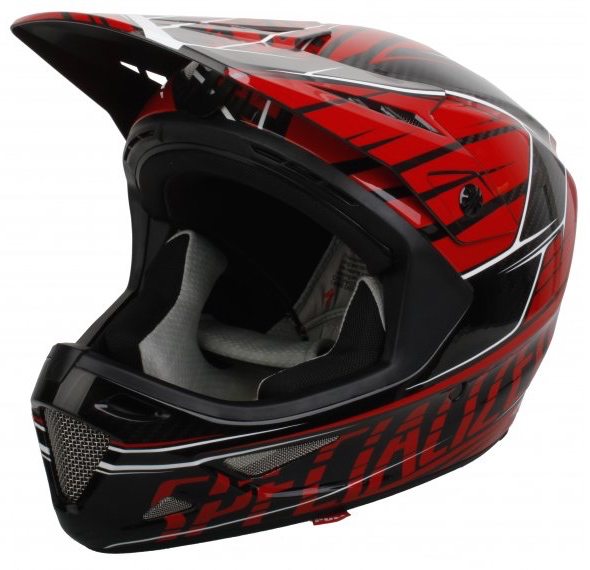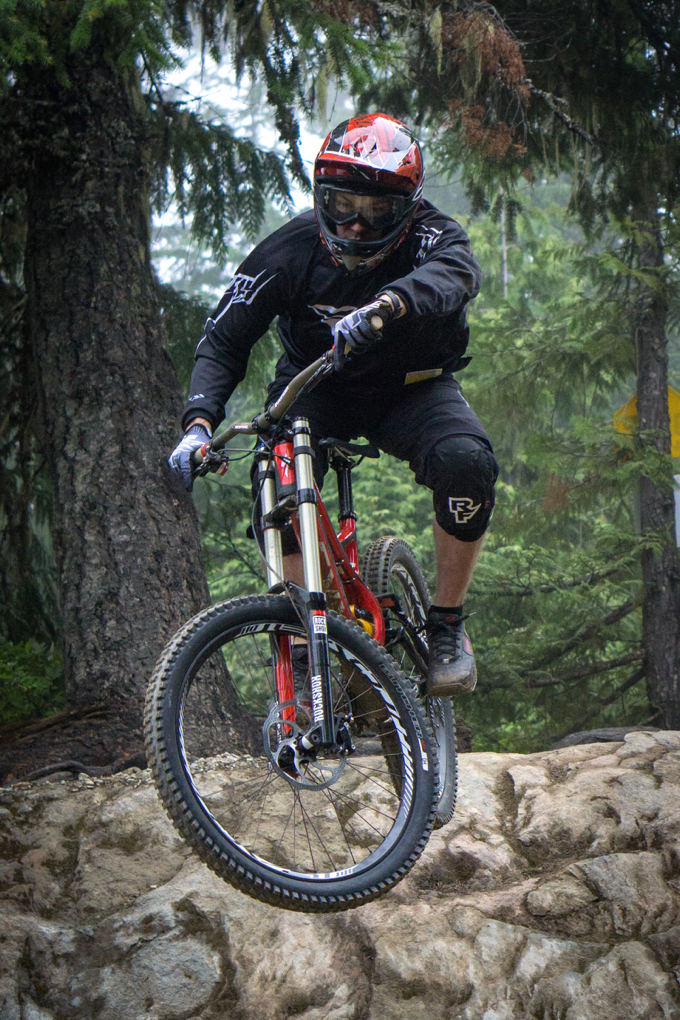
Specialized Dissident Helmet
Blister’s Measured Weight: 1064 grams
Size: Medium
Color: Red Octane
Features:
- Meets the ASTM DH safety testing standards for impact protection and chin bar performance
- Lightweight Carbon Matrix shell
- 4th Dimension Cooling and ventilation system
- Helmet EJECT system compatible
- Leatt brace compatible
- Speaker compatible
- Includes a padded travel bag with micro-fleece liner and external goggle pocket
- Complies with one or more of the following safety standards for bicycle helmets: CPSC, SNELL B-95, CE and ASTM 1952 (standard for downhill mountain bike racing helmets)
Days Tested: 7
Locations Tested: Whistler, BC; Park City, UT
I’ve always had trouble finding a good full face helmet that fits me well.
I spent a lot of time in an older model of the Troy Lee Designs D2 with no complaints, but eventually, the D2 needed to be retired, and the D3 that was meant to replace the D2 created a bad pressure point on my forehead.
The Giro Cipher worked, but it didn’t fit my head that well, and the Fox Rampage Pro created two pressure points on the side of my head. I considered investing in another D2, but other helmets were now offering more protection, which is certainly a priority for me. I was beginning to give up hope that I’d find a comfortable new helmet.
Then I tried on the Specialized Dissident helmet. Specialized’s full face helmets haven’t fit me well in the past, which is why I hadn’t considered any of their options a possibility; however I’ve found it to be a great helmet that should not be overlooked.
Reviewing Helmets & Safety Certifications
Helmet reviews are challenging. There are three important characteristics to evaluate: function, fit, and features. The helmet’s function, or protection, is usually evaluated by expensive testing equipment. A helmet undergoes a number of tests, and then is either awarded a certification or not. While one helmet may exceed the test requirements for impact absorption and another might barely meet them, both will be awarded the same certification.
Some companies create separate systems (i.e. MIPS) that could do a lot to help protect the brain from oblique impacts, but current bike standards don’t test for oblique impacts, making it hard to know how effective the systems are.
ASTM 1952 is a recently added test, which is specific to downhill bike helmets that also tests the chin bar of a full face helmet. There is still room for improvement regarding helmet function information. While this new test is a step in the right direction, I still believe there is room for improvement with requirements for more complete standards and more detailed information about testing results.
Certifications and Fit
The Dissident helmet complies with one or more of the following safety standards for bicycle helmets: CPSC, SNELL B-95, CE, and ASTM 1952.
Specialized says that it “meets the ASTM DH safety testing standards for impact protection and chin bar performance,” meaning it passed at least the ASTM 1952 test, and probably others.
While this is useful information and at least implies that the Dissident’s protection is comparable to most other full face helmets, I’d still love to see Specialized provide more information, perhaps some of the test results.
Specialized claims that the Dissident is one of the lightest full face helmets on the market, and I did find my Medium Dissident to be relatively light, weighing 1,064 grams. (For reference, the Troy Lee D3 is 1,125 grams.)

While the Dissident has a similar shape and measurements to the Giro Cipher, the Dissident’s padding is more plush, making it much more comfortable. It is not as soft as a moto-style helmet, but softer than average for a downhill helmet. It fit my moderately oval-shaped head well and didn’t create any pressure points.
As I mentioned above, my older TLD D2 helmet was excellent, but the D3 didn’t fit me well and the forehead pad pinched me (this possibly could have been fixed by cutting a plastic strip out, but they don’t let you do that on shop floor models…).
The Dissident actually has a very similar fit to my older D2, which I was impressed with and happy to see.
The Dissident is cooler than my Troy Lee D2, but not by much. I definitely wouldn’t want to pedal any significant distances with it on, but I felt the Dissident had pretty average venting. I don’t see the venting as a reason to either seek out or disregard the Dissident.
Features
The Dissident has a chin bar that is well shaped and doesn’t protrude much into one’s field of vision, but it does cover the chin well. I took one rock to the chin bar during a crash, and it took the impact without moving out of the way.
The main vent in the chin bar has an easily removable piece of 1” thick mesh foam behind it. I found myself keeping it in for muddy days so I wasn’t chewing on dirt and removing it on dry days so I could breathe a bit more easily.
The visor performed well; I didn’t notice it unless I was riding into the sun and then I was able to tip it down and get enough shade to allow me to see the trail. The visor never loosened, cracked, or got in the way.
The Dissident’s chin strap is a double d-ring. For 2015 Specialized, has moved to a one-handed magnet system, which I’d love to try. The d-ring is secure but slightly finicky, and requires practice and some dexterity. In particular, securing the extra strap with the snap was challenging with gloves on.
The cheek pads can slide out of the helmet when you pull on the side tabs. As an aftermarket accessory, you can purchase an air bladder system by Shock Doctor that makes cheek pad removal even simpler. The goal is to be able to remove the helmet after a potential neck injury without shifting the head. Thankfully, I did not have to test this functionality.
The rest of the helmet pads are easily removable and washable, making it easy to keep the funk away.
Specialized says that the Dissident is neck brace compatible, and while I have no reason to doubt them, I haven’t worn the helmet with a brace.
The Dissident has speaker-compatible ear pockets, although I never used them. I’m not into riding with music as I feel it cuts off the sense of community one can otherwise experience on the trail, as well as limits auditory information that might warn you of a person ahead or behind you.
The Dissident comes with a padded bag, which is really nice and should help keep the helmet looking fresh longer since it won’t be absorbing little dings in transit. It also allows me to keep my goggles with my helmet so that I never forget them.
Bottom Line
If the Specialized Dissident fits you and you dig its look, it is a great downhill helmet. Specialized has created a helmet that matches its competitors in terms of comfort, ventilation, and aesthetics, and beats many of them on weight.
